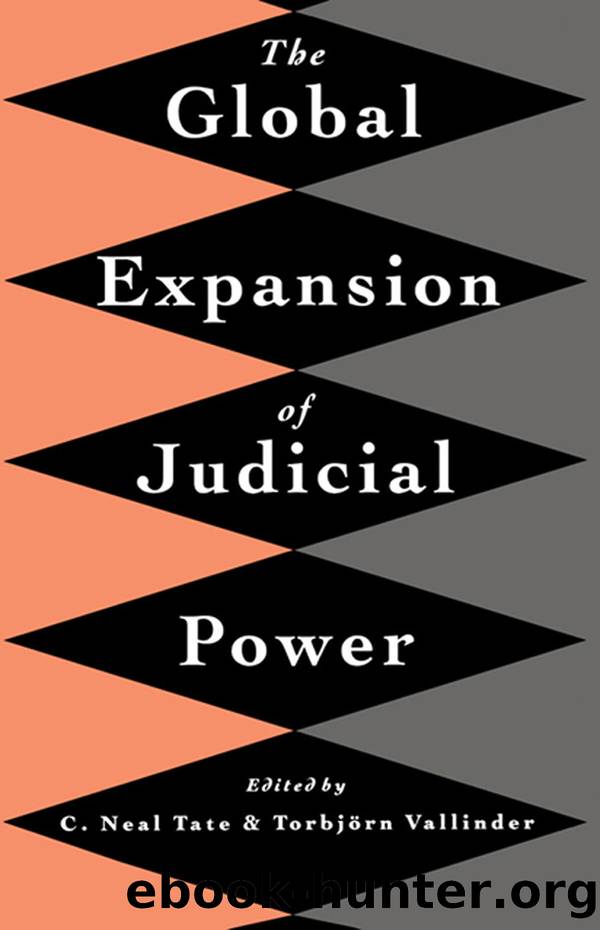The Global Expansion of Judicial Power by C Neal Tate & Torbjorn Vallinder

Author:C Neal Tate & Torbjorn Vallinder [Tate, C Neal & Vallinder, Torbjorn]
Language: eng
Format: epub
Tags: Law, Constitutional, Courts, Political Science, American Government, General, Religion
ISBN: 9780814782279
Google: 5mkTCgAAQBAJ
Barnesnoble:
Goodreads: 3301036
Publisher: NYU Press
Published: 1995-01-15T09:36:53+00:00
France and Germany
16.
France
JACQUELINE LUCIENNE LAFON
The judicialization of politics in France is a topic that has aroused important controversies. To comprehend the ins and outs of the matter, it is necessary to look back at the principles emerging from the Revolution of 1789 and the institutions established during the Consulat and the First Empire.
In 1789, a majority of deputies in the Constituante, the first national assembly, intended to reject all that had characterized the Ancien Régime. The confusion of powers was one of the main objects of criticism. The king held in his hands what would be considered today the legislative, executive and judicial powers. He could delegate these powers to officers. In such a system, the courts of justiceâparticularly the upper courts (parlements)âassumed judicial functions and when necessary established rules in the form of statutory decisions (arrêts de règlement), thus creating law.
During the last years of the Ancien Régime, philosophers and jurists criticized this system and feared the overwhelming power of the judges in parlements. Among the opponents was Montesquieu, who developed the theory of the separation of powers (see Pigacé-Mudry 1992).
The principle of separation of powers was affirmed in the Declaration of Rights of Man and Citizen of 1789, and the decree of August 16-24, 1790, forbade the arrêts de règlements. This second text was aimed very precisely at the limitation of the judicial power: the judgeâs sole function was to apply the law, even if he thought it was unconstitutional. He was not to criticize the law, he was not to interpret it. Should he consider it not precise enough, he had to refer it to the legislative power, that is, the national assembly, by means of the legislative reference instituted in the decree. Hence, the judge was not to create law.
Napoleon Bonaparteâs restructuring of France during the First Empire made three changes in the field of law that are relevant to our subject. First, Napoleon ordered great initial codifications of French private law: the Code civil (1804), the Code de commerce (1807), the Code de procedure civile (1807), the Code dâinstruction criminelle (1809), the Code penal (1810). Second, he established the two jurisdictional hierarchies that are still a part of the French system, the âregularâ or civil jurisdiction to judge all cases involving nongovernmental legal citizens and the administrative jurisdictions to decide disputes between citizens and the administrative authorities of the state. Third, Napoleon maintained the principle of the separation of powers, even though he neglected it in practice on occasion.
In this setting, in no way favorable to judges inclined to develop rules, a French jurisprudence creative of law appeared as soon as the early nineteenth century and has flourished throughout the years. This phenomenon aroused critics. According to the classical theory, a distinction should be made between political and nonpolitical organisms. Political organisms exercised creative and regulating functions, whereas nonpolitical organisms stood in a subordinate position and applied rules affirmed by the political organisms. In this analysis, judges did not constitute a third power in the state, an organism regulating society.
Download
This site does not store any files on its server. We only index and link to content provided by other sites. Please contact the content providers to delete copyright contents if any and email us, we'll remove relevant links or contents immediately.
Hollow Courts (2022) by Unknown(276)
The Crisis in America's Criminal Courts by William R. Kelly(256)
Mediation, Conciliation, and Emotions by Ladd Peter D.;Blanchfield Kyle E.; & Kyle E. Blanchfield(186)
I Dissent : Great Opposing Opinions in Landmark Supreme Court Cases by Mark Tushnet(185)
Settling Disputes by Linda Singer(174)
Equity and Gender by Ellen Frankel Paul(173)
A Lawyer in Indian Country by Alvin J. Ziontz(169)
The Puzzle of Unanimity by Corley Pamela C.;Steigerwalt Amy;Ward Artemus;(159)
The Nominee by Alan P. Woodruff(158)
How to Master Commercial Mediation by Richbell David;(155)
Judge and Jury by WILLIAM BERNHARDT(154)
In Defense of the Constitution by George W. Carey(148)
Madam Chief Justice by W. Lewis Burke Joan P. Assey(147)
Public Actors in International Investment Law by Catharine Titi(146)
War Crimes and the Culture of Peace by Louise Arbour(144)
Law, Courts, and Justice in America by Howard Abadinsky(137)
The National Security Court System by Sulmasy Glenn;(137)
The Trial and Execution of Mark and Phillis, Slaves of Capt. John Codman by Abner Cheney Goodell(130)
Kaleidoscope by Alan P. Woodruff(129)
